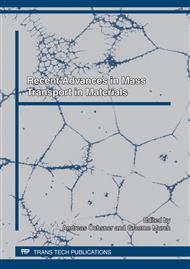p.33
p.41
p.73
p.87
p.107
p.129
p.151
p.163
p.175
Molybdenum Disilicide - Diffusion, Defects, Diffusion Correlation, and Creep
Abstract:
Molybdenum disilicide (MoSi2) is an interesting material for high-temperature applications. It has a high melting temperature, good thermal and electrical conductivity and an excellent oxidation resistance. For many years the primary use of MoSi2 has been in heating elements, which can be used for temperatures up to 1800°C. Since the 1990s the potential of MoSi2 as a high-temperature structural material has been recognized as well. Its brittleness at lower temperatures and a poor creep resistance above 1200°C have hindered its use as in load-bearing parts. These disadvantages may be offset at least partly by using it together with a second material in a composite or an alloy. Projected applications of MoSi2-based materials include, e.g. stationary hot section components in gas turbine engines and glow plugs in diesel engines. For future research and development directions of MoSi2-based composites diffusion is a crucial property because creep is closely connected with diffusion. This paper is devoted to the basic diffusion and defect properties of MoSi2. Data of Si and Mo as well as Ge diffusion from the Münster laboratory for both principal directions are briefly summarized. For all three kinds of atoms diffusion perpendicular to the tetragonal axis is faster than parallel to it. The diffusivities of Mo in both directions are many orders of magnitude slower than those of Si and Ge. The huge asymmetry between Mo and Si (or Ge) diffusion suggests that atomic motion of each constituent is restricted to its own sublattice. Positron annihilation studies on MoSi2 from the Stuttgart laboratory are reviewed as well. They show that formation of thermal vacancies occurs primarily on the Si sublattice but cannot exclude vacancy formation on the Mo sublattice at higher temperatures. Correlation factors for Si and Mo diffusion via sublattice vacancies in the respective sublattices of MoSi2 have been calculated recently mainly by Monte Carlo simulation techniques and are also briefly described. Diffusion, in particular self-diffusion, is discussed in connection with literature data on high-temperature creep, which is diffusion-controlled. Grain-size effects of creep have been reported and can be attributed to Nabarro-Herring and Coble creep. Power-law creep is attributed to diffusion-controlled dislocation creep. Some details are, however, not completely understood, presumably due to a lack of theoretical concepts for creep in uniaxial, stochiometric compounds and due to missing information on grain-boundary diffusion.
Info:
Periodical:
Pages:
107-128
Citation:
Online since:
March 2012
Price:
Сopyright:
© 2012 Trans Tech Publications Ltd. All Rights Reserved
Share:
Citation:


